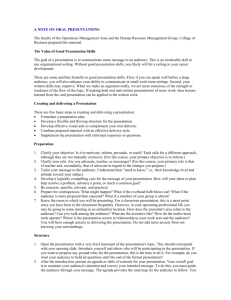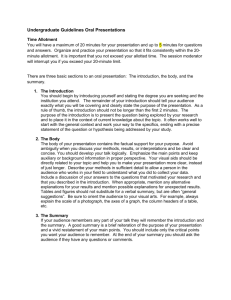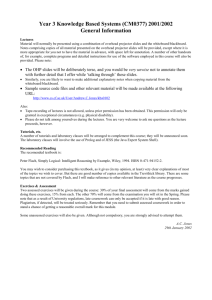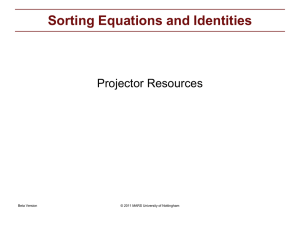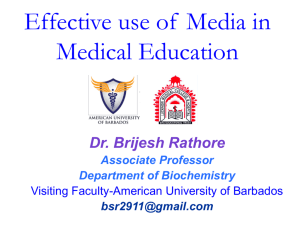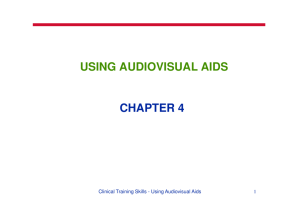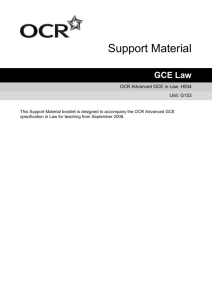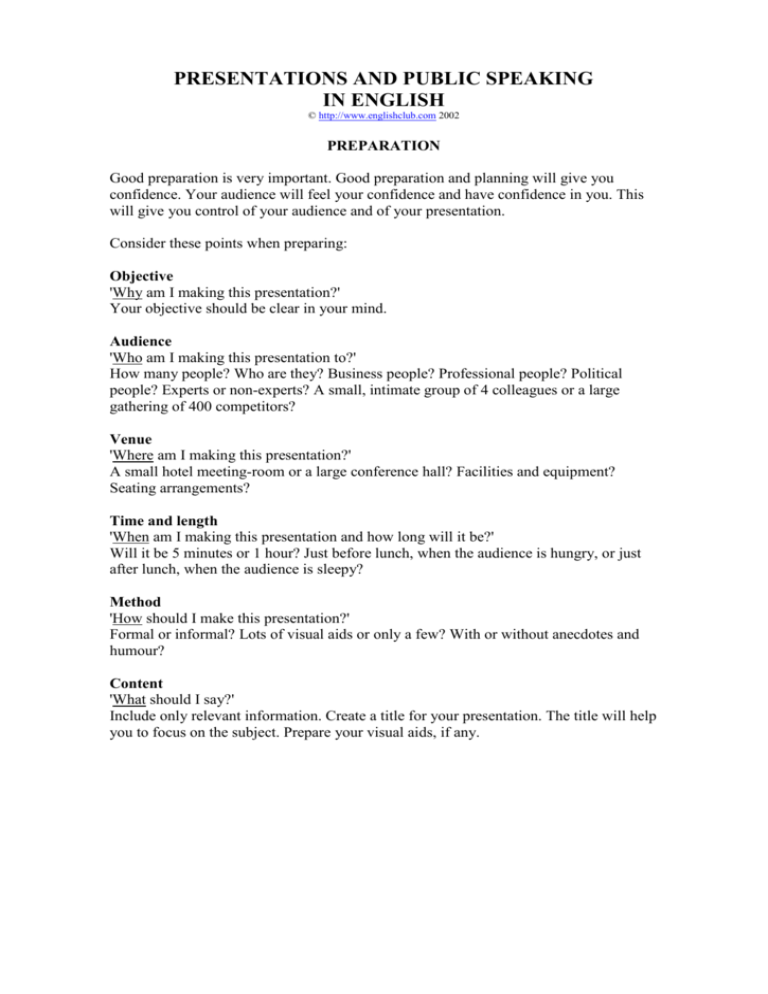
PRESENTATIONS AND PUBLIC SPEAKING
IN ENGLISH
© http://www.englishclub.com 2002
PREPARATION
Good preparation is very important. Good preparation and planning will give you
confidence. Your audience will feel your confidence and have confidence in you. This
will give you control of your audience and of your presentation.
Consider these points when preparing:
Objective
'Why am I making this presentation?'
Your objective should be clear in your mind.
Audience
'Who am I making this presentation to?'
How many people? Who are they? Business people? Professional people? Political
people? Experts or non-experts? A small, intimate group of 4 colleagues or a large
gathering of 400 competitors?
Venue
'Where am I making this presentation?'
A small hotel meeting-room or a large conference hall? Facilities and equipment?
Seating arrangements?
Time and length
'When am I making this presentation and how long will it be?'
Will it be 5 minutes or 1 hour? Just before lunch, when the audience is hungry, or just
after lunch, when the audience is sleepy?
Method
'How should I make this presentation?'
Formal or informal? Lots of visual aids or only a few? With or without anecdotes and
humour?
Content
'What should I say?'
Include only relevant information. Create a title for your presentation. The title will help
you to focus on the subject. Prepare your visual aids, if any.
Structure
Organise your presentation in a logical structure. Most presentations are organised in
three parts, followed by questions:
1 Introduction
- welcome your audience
- introduce your subject
- explain the structure of your presentation
- explain rules for questions
2 Body of presentation
- present the subject itself
3 Conclusion
- summarise your presentation
- thank your audience
- invite questions
+ Questions
Notes
Try to appear as spontaneous as possible. Do not read your presentation. Reading a text
is boring and will send your audience to sleep! Use notes to remember everything you
need to say. Some people make notes on small, A6 cards. Some people write down just
the title of each section of their talk. Some people write down keywords to remind them.
Rehearsal
Practise your presentation two or three times so that you:
- become more familiar with what you want to say
- identify weaknesses in your presentation
- can practise difficult pronunciations
- can check the time that your presentation takes and make any necessary modifications
EQUIPMENT
Your most important piece of equipment is YOU! Check your personal appearance
carefully.
Overhead Projector
The overhead projector (OHP) displays overhead transparencies (OHTs or OHPTs). It
has several advantages over the 35mm slide projector:
- it can be used in daylight
- the user can face the audience
- the user can write or draw directly on the transparency while in use
Whiteboard
The whiteboard is a useful device for spontaneous writing - as in brainstorming, for
example. For prepared material, the OHP may be more suitable.
Duster
The duster is used for cleaning the whiteboard.
Markers
Markers are used for writing on the:
- whiteboard (delible - you can remove the ink)
- flipchart (indelible - you cannot remove the ink)
Flipchart
The flipchart consists of several leaves of paper that you 'flip' (turn) over. Some people
prefer the flipchart to the whiteboard, but its use is limited to smaller presentations.
35mm Slide Projector
A slide projector must be used in a darkened room. Most slide projectors take 35mm
transparencies or slides, but projectors for 6x6cm slides are also available.
Notebook Computer
The notebook computer is often used with an overhead projector, to project an image
from the computer screen onto the wall screen.
Handouts
Handouts are any documents or samples that you 'hand out' (distribute) to your
audience. It is not usually a good idea to distribute handouts before your presentation.
The audience will read the handouts instead of listening to you.
DELIVERY
'Delivery' is the way in which you actually deliver or give your presentation. Delivery is
at least as important as content.
Nerves
Most speakers are a little nervous at the beginning of a presentation. So it is normal if
you are nervous. Pay special attention to the beginning of your presentation. This is
when you establish a rapport with your audience. During this time, try to speak slowly
and calmly. After a few moments, you will relax and gain confidence.
Audience Rapport
You need to build a warm and friendly relationship with your audience. Be careful to
establish eye contact with each member of your audience. Each person should feel that
you are speaking directly to him or her.
Body Language
What you do not say is at least as important as what you do say. Your body is speaking
to your audience even before you open your mouth. Your clothes, your walk, your
glasses, your haircut, your expression - it is from these that your audience forms its first
impression as you enter the room. Generally speaking, it is better to stand rather than sit
when making a presentation. Avoid repetitive and irritating gestures.
Cultural Considerations
If we imagine a German working for an Israeli company making a presentation in
English to a Japanese audience in Korea, we can see that there are even many
possibilities for cultural misunderstanding. Try to learn about any particular cultural
matters that may affect your audience. Cultural differences can often be seen in body
language. To a Latin from Southern France or Italy, a presenter who uses his hands and
arms when speaking may seem dynamic and friendly. To an Englishman, the same
presenter may seem unsure of his words and lacking in self-confidence.
Voice quality
Your audience must be able to hear you clearly. In general, you should try to vary your
voice. Your voice will then be more interesting for your audience. You can vary your
voice in at least three ways:
- speed: you can speak at normal speed, you can speak faster, you can speak more
slowly, and you can stop completely! Silence is a very good technique for gaining
your audience's attention.
- intonation: you can change the pitch of your voice. You can speak in a high tone. You
can speak in a low tone.
- volume: you can speak at normal volume, you can speak loudly and you can speak
quietly. Lowering your voice and speaking quietly can again attract your audience's
interest.
Visual aids
80% of what we learn is learned visually (what we see) and only 20% is learned aurally
(what we hear). This means that:
- visual aids are an extremely effective means of communication
- non-native English speakers do not need to worry so much about spoken English since
they can rely more heavily on visual aids
It is important not to overload your audience's brains. Keep the information on each
visual aid to a minimum - and give your audience time to look at and absorb this
information. Remember, your audience have never seen these visual aids before. They
need time to study and to understand them. Without understanding there is no
communication.
Apart from photographs and drawings, some of the most useful visual aids are charts
and graphs.
Audience Reaction
Remain calm and polite if you receive difficult questions during your presentation. If
you receive particularly awkward questions, you can suggest that the questioners ask
their questions after your presentation.
LANGUAGE
Simplicity and Clarity
If you want your audience to understand your message, your language must be simple
and clear:
- use short words and short sentences
- do not use jargon, unless you know that your audience understands it
- talk about concrete facts rather than abstract ideas
- use active verbs instead of passive verbs
Active verbs are much easier to understand. They are much more powerful. Consider
these two sentences, which say the same thing:
Sentence 1: Toyota sold two million cars last year.
Sentence 2: Two million cars were sold by Toyota last year.
Which is easier to understand? Which is more immediate? Which is more powerful?
Sentence 1 is active and Sentence 2 is passive.
Signposting
When you drive on the roads, you know where you are. Each road has a name. Each
town has a name. And each house has a number. You can look at the signposts for
directions. It is easy to navigate the roads. You cannot get lost. But when you give a
presentation, how can your audience know where they are? They know because you tell
them. Because you put up signposts for them, at the beginning and all along the route.
This technique is called 'signposting' (or 'signalling').
During your introduction, tell your audience the structure of your presentation, for
example:
"I'll start by describing the current position in Europe. Then I'll move on to some of the
achievements we've made in Asia. After that I'll consider the opportunities we see for
further expansion in Africa. Lastly, I'll quickly recap before concluding with some
recommendations."
A member of the audience can now visualise your presentation like this:
Introduction
- welcome!
- explanation of structure (now)
Body
- Europe
- Asia
- Africa
Conclusion
- summing up
- recommendations
Throughout your presentation, put up signposts telling him which point you have
reached and where you are going now. When you finish Europe and want to start Asia,
you might say:
"That's all I have to say about Europe. Let's turn now to Asia."
When you have finished Africa and want to sum up, you might say:
"Well, we've looked at the three continents Europe, Asia and Africa. I'd like to sum up
now."
And when you finish summing up and want to give your recommendations, you might
say:
"What does all this mean for us? Well, firstly I recommend..."
Here are some useful expressions to signpost the various parts of your presentation.
Introducing the subject:
"I'd like to start by..."
"Let's begin by..."
"First of all, I'll..."
Finishing a subject:
"Well, I've told you about..."
"That's all I have to say about..."
"We've looked at..."
Starting another subject:
"Now we'll move on to..."
"Let me turn now to..."
"Next..."
Analysing a point and giving recommendations:
"Where does that lead us?"
"Let's consider this in more detail..."
"What does this mean for ABC?"
Giving examples:
"For example,..."
"A good example of this is..."
"As an illustration,..."
Dealing with questions:
"We'll be examining this point in more detail later on..."
"I'd like to deal with this question later, if I may..."
"I'll come back to this question later in my talk..."
Summarising and concluding:
"In conclusion,..."
"Right, let's sum up, shall we?"
"I'd like now to recap..."
Ordering:
"Firstly...secondly...thirdly...lastly..."
"First of all...then...next...after that...finally..."
"To start with...later...to finish up..."
THE PRESENTATION ITSELF
Most presentations are divided into 3 main parts (+ questions):
- Introduction
- Body
- Conclusion
As a general rule in communication, repetition is valuable. In presentations, there is a
golden rule about repetition:
"SAY WHAT YOU ARE GOING TO SAY, SAY IT, THEN SAY WHAT YOU HAVE
JUST SAID."
In other words, use the three parts of your presentation to reinforce your message:
In the introduction, say what your message is going to be.
In the body, say your real message.
In the conclusion, say what your message was.
Introduction
Use the introduction to:
Welcome your audience:
"Good morning, ladies and gentlemen"
"Good afternoon, everybody"
Introduce your subject:
"My purpose today is to introduce our new range of..."
"I am going to talk about..."
Outline your structure:
"To start with I'll describe the progress made this year. Then I'll mention some of the
problems we've encountered and how we overcame them. After that I'll consider the
possibilities for further growth next year. Finally, I'll summarise my presentation
(before concluding with some recommendations)."
Give instructions about questions:
"Please feel free to interrupt me if you have any questions."
"I'll try to answer any of your questions after the presentation."
Body
The body is the 'real' presentation. If the introduction was well prepared and delivered,
you will now be 'in control'. You will be relaxed and confident.
The body should be well structured, divided up logically, with plenty of carefully
spaced visuals.
Remember these key points while delivering the body of your presentation:
- do not hurry
- be enthusiastic
- give time on visuals
- maintain eye contact
- modulate your voice
- look friendly
- keep to your structure
- use your notes
- signpost throughout
- remain polite when dealing with difficult questions
Conclusion
Use the conclusion to:
Sum up:
"In conclusion,..."
"I'd like to sum up now..."
Give recommendations:
"In conclusion, my recommendations are..."
"I would suggest / propose / recommend the following strategy."
Thank your audience:
"Thank you for your attention."
"May I thank you all for being such an attentive audience."
Invite questions:
"Are there any questions?"
"Can I answer any questions?"
Questions
You may wish to accept questions at any time during your presentation, or to keep a
time for questions after your presentation. It's your decision, and you should make it
clear during the introduction. Be polite with all questioners, even if they ask difficult
questions. Sometimes you can reformulate a question. Or answer the question with
another question. Or even ask for comment from the rest of the audience.
REVIEW
In this seminar, you have learned:
-
to allow plenty of time for preparation
to ask the all-important questions: why? who? where? when? how? what?
to structure your presentation into introduction, body, conclusion and questions
to write notes based on keywords
to rehearse your presentation several times and modify it as necessary
to select the right equipment for the job
to use equipment effectively
to make use of clear, powerful visual aids that do not overload your audience
to use clear, simple language, avoiding jargon
to use active verbs and concrete facts
to explain the structure of your presentation at the beginning
to link each section of your presentation
to signpost your presentation from beginning to end
to say what you are going to say, say it, and say what you have just said
to overcome your nerves
to establish audience rapport
to be aware of your body language
to understand cultural differences
to control the quality of your voice
to maintain interest by varying the speed, volume and pitch of your voice
to deal with listeners' questions politely
to respond to your audience positively
This document may be copied and distributed in its entirety for non-commercial purposes
provided its content is not modified. © http://www.englishclub.com 2002 All rights reserved


